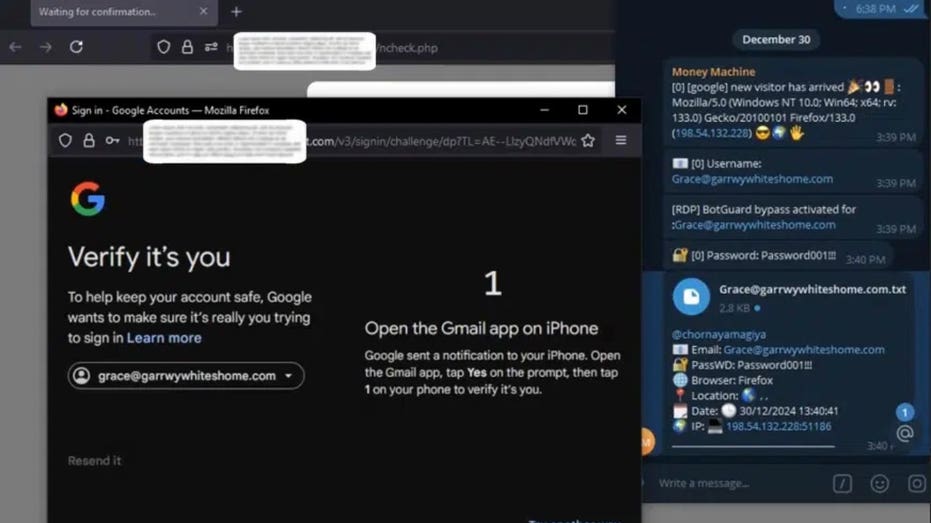- by foxnews
- 08 Apr 2025
New phishing attack uses real-time interception to bypass 2FA
This phishing kit bypasses 2FA via session hijacking and real-time credential theft. Kurt "CyberGuy" Knutsson offers four ways to stay safe from Astaroth phishing attacks.
- by foxnews
- 01 Apr 2025
- in technology

Phishing attacks are everywhere, and most of us can spot the obvious ones. Even if someone falls for one and hands over their password, two-factor authentication (2FA) usually adds a crucial layer of protection. But a new phishing kit making the rounds can bypass 2FA entirely by using session hijacking and real-time credential interception.
Known as Astaroth, this tool intercepts and manipulates traffic between your device and legitimate authentication services like Gmail, Yahoo and Microsoft. Since it grabs everything in real time, it completely bypasses 2FA and gives attackers full access to your account.
Astaroth is a next-level phishing kit that takes scamming to a whole new level. Instead of using basic fake login pages like traditional phishing kits, it works as a middleman between your device and the real authentication service while silently grabbing everything needed to break in.
The attack begins when you click on a phishing link and land on a malicious site that looks identical to the real one. Since the site has valid SSL certificates, there are no red flags, no security warnings and no sketchy pop-ups. When you enter your login details, including username, password, device info and IP address, Astaroth snatches them up before passing the request to the actual website.
The real kicker is that Astaroth also grabs session cookies, which are the small bits of data that keep users logged in after authentication. Attackers can inject these cookies into their own browsers, skipping the need for passwords or two-factor authentication altogether. Once they have the session, they are in with no extra steps required.
Beyond its advanced capabilities, Astaroth comes with features that make it appealing to cybercriminals. It uses bulletproof hosting to stay online despite law enforcement efforts, receives frequent updates to bypass security patches and follows a structured payment model. For $2,000, buyers get six months of continuous upgrades. To build trust, the creators even let hackers test the phishing kit before purchasing.
Astaroth is widely available through Telegram and underground cybercrime forums. The anonymity of these platforms makes it difficult for authorities to track distribution.
1) Unexpected account logins or security alerts
2) You're mysteriously logged out of accounts
3) Password changes or settings updates you didn't make
4) Slow system performance or odd behavior
5) Browser acting strangely
6) Unfamiliar programs or scripts running in the background
1) Avoid unknown links and use strong antivirus software: Remember that no matter how advanced the malware is, it still needs input from you. In most cases, an attacker will require you to click a link before they can steal your data. For example, for Astaroth to work, you have to click a link, visit a malicious website and enter your credentials. If you don't click the link, you stay clear of the malware.
2) Double-check sites: Always verify website addresses and use bookmarks for trusted sites. Instead of clicking on links in emails or messages, manually type the URL or use a trusted bookmark. This minimizes the risk of landing on a fraudulent page designed to mimic a legitimate website.
4) Avoid typing passwords: Avoid entering passwords whenever possible to reduce the risk of credential theft. Instead, use authentication methods like passkeys, Google Sign-In or Apple Sign-In.
Apple Sign-In is a feature that enables you to privately sign in to participating third-party apps and websites using your Apple ID. It offers a fast, easy and more private way to authenticate without the need to create new accounts or remember additional passwords. To set up an account to "Sign in with Apple," when a participating website or app asks you to set up or upgrade an account, do the following: Tap Sign in with Apple. Follow the onscreen instructions. Some apps (and websites) don't request your name and email address. In this case, you simply authenticate with Face ID or Touch ID (depending on your model), then start using the app. Others may ask for your name and email address to set up a personalized account. When an app asks for this information, Sign in with Apple displays your name and the personal email address from your Apple Account for you to review.
These methods rely on cryptographic keys or secure tokens, making it much harder for attackers to intercept your login information, even if they manage to trick you into visiting a malicious site.
Astaroth shows just how far phishing kits have come, taking things beyond the usual tricks and bypassing 2FA with ease. It's a reminder that no matter how secure we think our systems are, there's always a smarter attack waiting to exploit the gaps. Cybercriminals are adapting fast, and while traditional defenses may not cut it anymore, there are still steps you can take to fight back: use passwordless logins, stay updated and keep learning about these evolving threats.
Follow Kurt on his social channels:
Answers to the most-asked CyberGuy questions:
New from Kurt:
Copyright 2025 CyberGuy.com. All rights reserved.
- by foxnews
- descember 09, 2016
Ancient settlement reveals remains of 1,800-year-old dog, baffling experts: 'Preserved quite well'
Archaeologists have recently unearthed the remarkably well-preserved remains of a dog from ancient Rome, shedding light on the widespread practice of ritual sacrifice in antiquity.
read more





